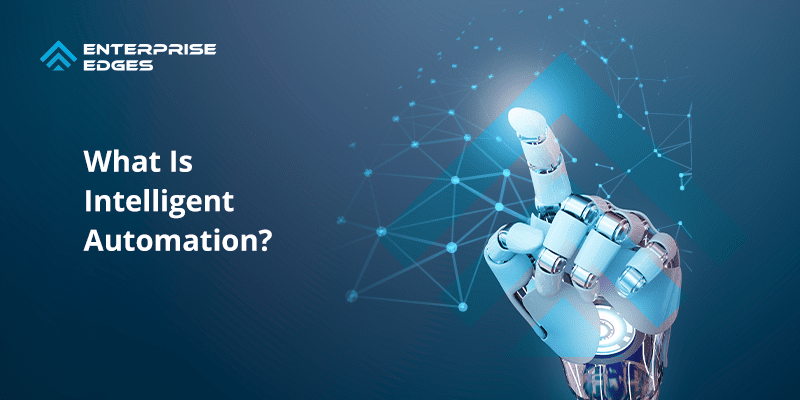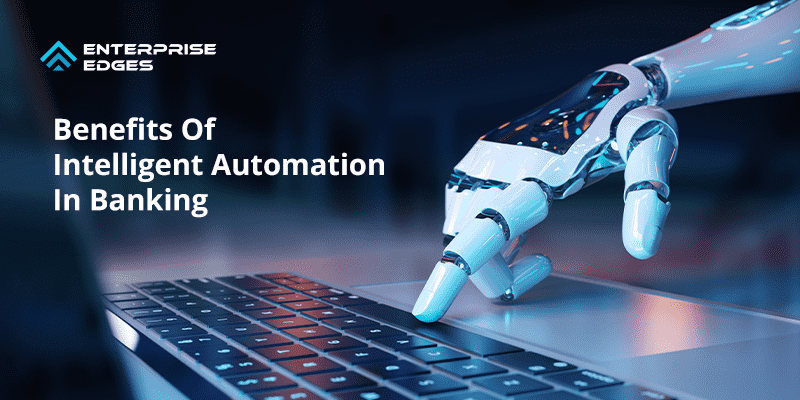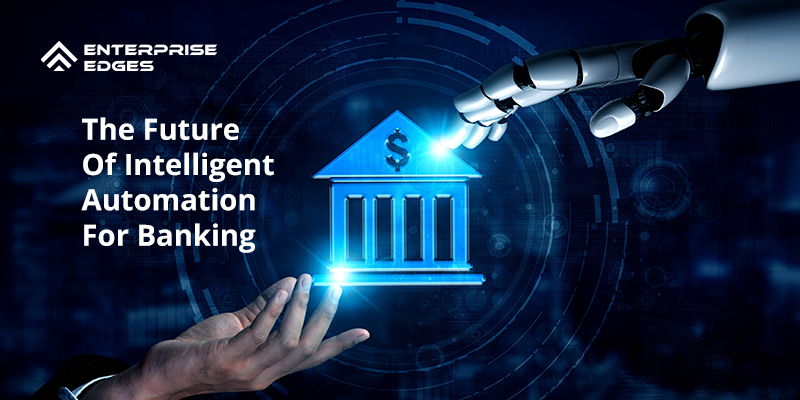With automation technologies streaming in with their latest versions swiftly and playing substantial roles across all industries, it is time for organizations to apply automation for a quicker and seamless flow of business operations. Out of the many technologies controlling the banking industry, Intelligent Automation (IA) is one of the best solutions for its capabilities to reduce the cycle time, enhance accuracy and productivity, and better regulatory compliance.
With the banking and finance processes getting more complex with each passing day, it can overburden the department handling the job with its human workforce entirely. Therefore, IA comes as an ideal solution for the banking industry that avoids the hiccups and reduces the errors besides other risks involved.
However, before going too deep, let us first have a basic idea of Intelligent Automation and its benefits.
What is Intelligent Automation?

Intelligent Automation solution is an end-to-end business process tool combining AI (Artificial Intelligence), ML (Machine Learning), NLP (Natural Language Processing), computer vision & RPA (Robotic Process Automation) to drive processes efficiently. These cognitive digital processing technologies unify human-bot interfaces to deliver accurate & speedy results. Moreover, their scalability makes them a flexible & versatile platform for various industries.
How do Intelligent Automation Solutions Work?
An intelligent automation platform operates on the following principles:
- Process discovery is driven by digital technologies such as RPA for disaster management
- Multichannel customer accessibility & optimization, including attended chatbots
- Analytics & Insights: promotes commercial and operational discipline by scrutinizing existing conventional systems for conflicts & redundancies via process discovery itself
Let us explore some of the applications within the banking industry.
Benefits of Intelligent Automation in Banking

Intelligent automation banking drives logical reasoning and decision-making abilities through algorithmic intelligence. By integrating various resources, making efficient savings & driving human capital-based tasks (rather than clerical wastage), output productivity can be increased. Legacy systems can be connected entirely, while unstructured data can be organized too. Moreover, digital workers deep learn autonomously & deliver unparalleled exception handling.
Accuracy & security, along with privacy, can also be collectively boosted. Audit compliance, KYC & record management are also driven to their peak performance (with recommended regulatory practice adherence). Consequently, customer satisfaction, experience & turnaround times can all be enhanced as well. This delivers more consistent results – every time.
How Intelligent Automation Supports Banking

IA drives accuracy, availability, efficiency & scalability: all within a unified framework which ensures connectivity. It serves RPA reporting, mortgage processing, KYC, fraud detection & even more. The problem lies with adoption resilience for scaling, outdated infrastructure creating compatibility/support issues, and resultant process misalignment. Nevertheless, as AI even safeguards against money laundering within seconds, it is no wonder that it leads to the development of a stabilized processing protocol.
As a result, risks can be mitigated, multitasking can be truly promoted, user experience improvements implemented, seamless task completion, informed decision making, collections & monitoring. Moreover, AI-based service engagement to customize offerings per demographics with input detection can innovate the entire experience. Analytical data marketing can provide insights into trends.
Collectively, this drives competitive advantage via more streamlined processes for both customers & employees. Hyperautomation drives loan processing, shaving a third off the processing time while qualitatively maintaining accuracy. Customer management systems can be integrated within an app or web-based data capture forms for convenient information retrieval. This does away with manual clerical work, saving ample time, which can then be reinvested in other more productive tasks, such as commercial expansion. KYC data collation has never been so easy & precise!
Moreover, credit score analysis, loan presentation, monitoring, automated loan processing, risk management & accounting tax detail verification can all be undertaken by intelligent automation. Now documents can be processed reliably, with comprehensive insights & offering speedy solutions with minimized chances of scaled processing. Spurious data can also be flagged. Now with faster processing time & human error eradicated, what is there not to like?
Personalized finance & wealth management – AI bots provide live data insights into market risks, ROI, expected investments, etc. Customized pathways can be developed for individual portfolios. However, a staff skills shortage & tight government regulations restrict its adoption. Furthermore, a large portion of existing data is already inaccurate, which does not help. Moreover, data silos need to be opened up & connected or integrated within legacy systems, while banks remain skeptical about AI for their business. Credit analysis is another feature of AI within the banking industry.
The Future of Intelligent Automation for Banking

Additional to the advantages mentioned above, AI will continue to drive unified processes for customers while easing data management for banks. This way will all be driven seamlessly, be it updating details, tracking financial transactions, or anything else. Such activities, including home, net & offline banking, can be automated, analyzed & secured even further for optimal performance. Furthermore, driving intelligent automation will make processes faster, even more, secure & trackable. This means that activities that require visiting the bank or awaiting ‘working hours’ or business days can be performed almost anytime. In addition, international transfers will become even easier & quicker.
Furthermore, intelligent automation will give customers more autonomy to a bank – empowering them with complete control over their money. It is expected that over the next decade or so, banks will restructure their operations by integrating digital (crypto)currencies, such as Bitcoin, for a better user experience. This is how & where all the innovation will truly begin. By doing so, we can also ensure that ownership is taken to mitigate the risks associated with online transactions. Fraud will be curbed, as will the ability to verify & authenticate one’s identity – from virtually anywhere in the world. With this robust infrastructure, efficiency will be a crucial driver in maintaining such protocol.
Conclusion
Banking institutions, financial leadership, and government agencies must collaborate to form a globally powered & unified, intelligent banking system. Teething & hindering issues such as lack of training, infrastructural support, sluggish adoption, or even reluctance to do so really need to be addressed. We must educate the wider world about the gains of Intelligent Automation and its standing in our society. Our future is bright & promising – however, it will only shine as per our collective efforts. Apathy in driving future digital transformation and misleading theories about the risks of doing so will only keep everyone in the dark ages (as it were).
Intelligent Automation is here to stay, flourish & deliver efficiency, versatility, speed, scalability & security. Hence, we must embrace this revolution as soon as possible to maximize the benefits that can be reaped from it. If we do not, we can only face continual challenges and consequences of aging outdated conventional systems and their inefficiencies. This is frankly pointless, don’t you feel?
